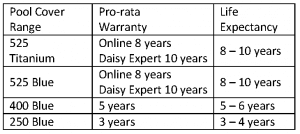Frequently Asked Questions
Check out our FAQs below. We also have video resources and handy tips for your pool care.
What Are My Water Restrictions?
Water restrictions vary by region or water authority.
At Daisy, we work hard to ensure our pool covers are the most economically sensible. Also, to make sure people know it’s OK to have a swimming pool. This is because with a Daisy Pool Cover, you can be environmentally responsible while you enjoy your backyard.
Will Pavers Crack When Installing Winterkleen Fittings?
When drilling into paving, all care is taken to avoid damage including chipping of surfaces and cracking of pavers.
Unfortunately, due to the existing surface or the way existing paving was laid, the age of the paving and the drilling method. We cannot guarantee that there will be no damage nor cracking of the paving or surroundings during the drilling and installation of the plugs.
No responsibility can be taken for damage that may occur during this style of installation.
What is a Breathable Pool Cover?
Recently, the industry has seen the introduction of a so-called “breathable pool cover”. At Daisy Pool Covers, we were intrigued by this new pool cover with holes punched in it and thought we would explain what they do and how they work.
Taking a close look at this new breed of pool cover, they are designed with holes punched though the cover. The covers benefits claim that when you allow your pool to breathe, it results in a cleaner, longer lasting pool and a healthier swimming environment. What the team at Daisy Pool Covers discovered was it doesn’t matter what type of pool cover you purchase. There is absolutely no alternative to looking after your pool’s chemical balance and uncovering your pool water once in a while.
Please click here for more detailed information on pool covers.
What Side Faces the Water?
Install with the bubble side facing the water so you can see the flat surface.
Can I Use A Pool Cleaner Under My Pool Cover?
Yes, you can use any suction, pressure or robotic pool cleaner under your pool cover.
Your pool cover does not hinder the pool cleaner operation
Why Does My Cover Lift Higher on One Side While Being Short on the Other Side?
This phenomenon is caused by what we call an inside curve. Adding dressmaking tucks to the curve on some pools, such as kidney shaped ones, will help stop the blanket lifting unevenly, which can be caused by an inside curve. For instance, if you have a kidney-shaped pool, you will find that the material will tend to push from point A towards point B. This is caused by the 75mm upturn of the over cut material trying to straighten itself out. It is curved and too large so it creates a downward force. This force is transferred downwards from point A towards point B. If you put some dressmaking tucks into the curve around the A section then this force is contained and the cover will remain stationary.

Do I Have to Cover All of the Water?
From the point of view of heating efficiency, no. It will heat effectively even if the pool is not totally covered, however, it will allow dirt and debris into the pool. An edge along a step or an uncovered area will provide a point at which the wind can start to worry the cover and may eventually lift it off the pool.
Will the Cover Blow Off?
Provided it is properly fitted, it will not. The effect of the bubbles going down in the water creates more surface area in contact with the water than the flat pool area. Therefore, the surface tension is quite high. Furthermore, provided the edges of the cover do not rise above the coping, the effect of any wind is to create a downward pressure. The downward pressure pushes the cover onto the water.
If the cover edge rises above the coping because it has been cut too large, or winter rain has raised the pool water level and hence the cover. Then the wind can get under the cover and send it flying into your favourite rose bush (or similar).
Should I Take the Cover Off If It Gets Too Hot?
Yes. If the air temperature exceeds 35ºC, it is better to remove the cover and place it in a protected, cooler spot. If you have it on a roller with the over-cover on and the temperature reaches this level, it is better to move the cover and roller into the shade.
How Do I Protect the Cover When It Is Off the Pool?
If you have a Roller System, use the white overcover supplied every time you roll up the cover. If you don’t have a Roller System, the cover must be removed and placed completely in the shade. It must never – not even for a few minutes – be left in the sun when folded. This is because the heat generating effect of the cover is magnified immensely when folded and it will very quickly self-destruct. The results may not be immediately visible, but they can be very serious.
There can be so much heat created that the air expansion creates sufficient pressure to force the lamination of the two sheets apart. This causes the bubbles to join and form lines of larger bubbles. This is not life-threatening to the cover unless repeated consistently. However, the cover can get so hot that it becomes molten and welds itself together – completely ruining it.
What Can I Do to Prolong the Life of My Daisy Solar Pool Cover?
1. Ensure the chlorine level never exceeds 3ppm (3 parts chlorine to 1 million parts water). This level is shown as normal or ideal on your test kit. It is probably best to maintain your chlorine level at 2 to 2.5ppm. This level provides the recommended level of sanitation and guarantees your family’s safety. Higher chlorine levels increase the corrosive effects on the cover, and do not increase health standards. In fact, too much chlorine can be potentially damaging to your health.
2. Run your filter during the hottest part of the day – 10am to 4pm. Normally, when your filter is installed and set up, it is assumed you don’t have a solar pool cover. The filter is set up accordingly by the service person. You’ll be told that if you run your filter during the hottest part of the day your chlorine use will increase. Chlorine in its natural state is a gas.
However, you add it to the pool water (liquid, solid or gas), it reverts to its natural state – a gas, which rises through the water and into the atmosphere. When you put a solar pool cover on, much of this evaporation does not occur. Instead, the chlorine continues to circulate through your pool water via your pump and filtration system and continues to sanitise the water.
How Much Chlorine Do I Add with a Daisy Pool Cover?
This means the volume of chlorine in the pool will increase and your water will test higher. With a Daisy solar pool cover, you need to avoid this higher concentration by reducing the input of chlorine into the pool by about 50%. Either put less in (if you physically add chlorine), or turn down the amp-meter if you have a salt water chlorinator.
A further reason to run your filter during the hot part of the day is that when the sun heats the water it only penetrates the thermal layer – about 200 – 250mm or 8 – 10 inches. The sun is only heating the top layer of the pool, which gets hotter and hotter, while the water beneath remains cool. Add high chlorine concentration to this heat, and the effect of UV rays, and it is the worst possible environment for your swimming pool cover.
By setting up your pump to run during this hot part of the day, you can relieve this heat and get the chlorine evenly distributed through the water again. The pump mixes up the warmer and cooler water to spread the heat and mixes the chlorine throughout the pool and stops it building up under the cover. This allows you to gain the most of the benefits of a Daisy solar pool cover and prolong its life.
How Hot Will My Pool Get?
The water temperature will rise by 6–8ºC above the average ambient temperature measured over about a week. Most people find they double their swimming season with a Daisy solar pool cover. It is quite normal in mid-summer for the pool to reach 30ºC or more. At which point it will probably be too hot, and you will have to leave the cover off for a period to allow it to cool down.
How Do I Get the Dirt Off the Cover?
There will not be as much dirt in the pool if a cover has been used. Dirt will land on the cover and then blow off with the next puff of wind. Without a cover the dirt gets wet and sinks into the pool. Dirt will also tend to end up in one spot, depending on the prevailing wind. You can scoop it off with your hands, or use a broom and dustpan to remove it. You can also turn on your pump and hose the dirt towards your skimmer box. A Daisy pool cover without a roller is quite a large piece of material, and in practical terms is much easier for two people to handle.
You should have one person on either side and concertina the cover on the ground, then fold the sides to the middle, pick it up and store in the shade—not under shade cloth. If only one person is available, they should kneel at the end of the pool, lean out as far as possible, pick up the centre of the cover and draw it towards themselves forming the concertina beneath their knees. A solar pool cover lives in a very harsh environment. It is constantly attacked by the chlorine in your pool water and UV rays from the sun. The effects of both are magnified by high summer temperatures.
It is the combination of:
- Concentration of sanitation chemicals—usually chlorine—in the pool water
- Intensity of UV rays
- Heat of the pool water.
What is UltraDomeTM?
Daisy’s advanced UltraDomeTM bubble is the key to the outstanding efficiency and long life of our solar pool cover. Exclusive to Daisy, the UltraDomeTM technology completely eliminates weak points in the bubble which can eventually wear and break down. Daisy’s advanced manufacturing techniques use super toughened polyethylene containing the maximum antioxidants, tougheners and UV inhibitors to resist salt, sun and chemicals. Together, these factors mean a stronger cover that will last longer.
Daisy’s advanced UltraDomeTM bubble is the key to the outstanding efficiency and long life of our solar pool cover. Exclusive to Daisy, the UltraDomeTM technology completely eliminates weak points in the bubble which can eventually wear and break down. Daisy’s advanced manufacturing techniques use super toughened polyethylene containing the maximum antioxidants, tougheners and UV inhibitors to resist salt, sun and chemicals. Together, these factors mean a stronger cover that will last longer.
Daisy pool covers do have a finite lifespan and will eventually require replacement. Remember, your care of the cover will ultimately determine its life.
Typical life expectancies:

When you purchase a Daisy pool cover and roller system, you are effectively committing to an ongoing replacement cost, on top of the initial cover and roller system purchase. This cost will amount to between $80 and $120 per year depending on how well you look after your pool cover.
This is around $2.00 per week, which is a small price to pay for the many considerable benefits of owning a Daisy solar pool cover. You can take actions to prolong the life of your Daisy solar pool blanket. UltraDomeTM bubble technology is the heart of our Daisy pool cover structure. The UltraDomeTM bubble profile results in a total insulating air layer to the majority of the bubble depth. The air in the bubble and the air trapped between the top layer of the cover and the water effectively form a thick layer of insulation across the entire cover area.
What Are Thermal Pool Covers?
Thermal resistance is crucial in determining insulation efficiency. The Daisy 525-micron pool cover boasts an impressive 0.067m2 K rating. This cover impedes water evaporation, a process that sees water turning to vapor and escaping into the air. Factors influencing water loss include pool surface area, water and air temperatures, humidity, and wind. This cover shields against these factors, allowing the sun’s warmth to penetrate the water, similar to a garden hot house. Consequently, the heated water remains warm under the pool cover, ensuring minimized costs and an environmentally-friendly choice. Daisy pool covers also serve as a barrier between the pool water and atmospheric temperatures.
Why are Pool Covers Essential?
A pool cover reduces water evaporation, heat loss, and the escape of chlorine gas. It’s essential to install the cover up to the maximum water line and test the BGB operation. There might be some concerns with the cover catching on pool edges, but simple adjustments can resolve these. Notably, square pools or those with non-round paving may grip the cover more. When drilling into paving for installation, care is paramount to avoid damage. Still, no guarantees are made against potential damage during installation.
How Do Electric Rollers Enhance the Pool Experience?
The Daisy Power offers the advantage of an electric roller without consuming excessive space. It efficiently rolls up your cover, and can be retrofitted onto most Daisy rollers. The standard package includes a battery-operated electric roller, an AC charger, two remotes, and control buttons.
Are There Environmentally Friendly Options for Rollers?
Certainly! You can upgrade to a solar panel to recharge your Daisy Power. This utilizes the sun, ensuring the roller is always prepared for use. Additionally, it’s vital to consider various factors, like rope installation and over-cover storage, that might affect the roller’s movement, especially during windy conditions.
What Are the Benefits of a Daisy Roller System?
A Daisy Roller System enhances the convenience of using a pool cover. It promotes proper use, ensuring you reap maximum benefits. It offers easy storage, eliminating the need to shift the cover into the shade. Each Roller System comes with a protective over-cover at no extra charge.
Are There Pool Cover Installation Tips?
Certainly. For uniquely shaped pools or those with steps, ensure a clear line of sight from the roller edges down the cover before rolling. Adjust the roller’s position, cords, and ensure the cover rolls over the roller tube for efficient usage. Some issues like cover shrinkage or wrinkles may occur due to manufacturing processes but don’t impact the cover’s efficacy.
Are Pool Covers OK in the Sun?
Pool covers should be stored in complete shade when not in use. Daisy pool covers are manufactured using panels of material welded together, ensuring durability and efficiency. They’re also infused with UV inhibitors to counteract the damaging effects of the sun. However, prolonged exposure to sunlight and pool chemicals can degrade the cover over time. Monitoring and maintaining chlorine levels is crucial to prolong the cover’s lifespan.
What Should You Know About Daisy Solar Pool Covers?
Factors like high algae concentration, punctures, and de-lamination can affect your pool cover’s performance. Handling with care and ensuring protection from sharp objects and excessive sunlight can prolong its lifespan. Proper installation, like ensuring a correct upturn, prevents the cover from being blown off by the wind. If the cover keeps moving to one side, consider adjusting its size or consulting the manufacturer’s guidelines.

